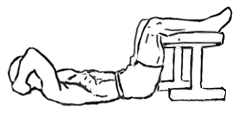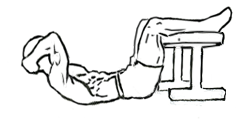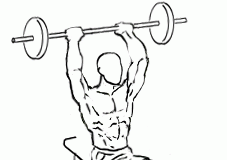Last Updated on September 30, 2022
When it comes to building a strong, toned core, crunches are often the first exercise that comes to mind. Crunches are one of the most common and popular abdominal exercises, but they are also one of the most commonly performed incorrectly. To maximize the benefits and minimize the risk of injury, it’s crucial to perform crunches with proper form and technique.
In this detailed guide, we’ll break down everything you need to know about crunches: from the step-by-step instructions on how to execute them correctly, to the common mistakes to avoid, variations to try, and tips for improving your core strength overall. By the end of this article, you’ll have a thorough understanding of how to use crunches effectively in your fitness routine.
What Are Crunches?
Crunches are a fundamental core exercise that specifically targets the abdominal muscles, or abs. Unlike sit-ups, which involve lifting the entire upper body off the floor, crunches focus solely on engaging the upper abs by curling the shoulders and upper back off the ground. This movement isolates the rectus abdominis, the muscle group responsible for that coveted “six-pack” appearance, making it an ideal exercise for developing core strength and definition.
Despite their simplicity, crunches require precise execution to be effective. Done improperly, they can place unnecessary strain on the neck and lower back, reducing their effectiveness and potentially leading to injury.
Benefits of Crunches
Crunches offer several benefits, particularly when performed with the correct technique. These include:
- Core Strength: Crunches effectively target the rectus abdominis and help build core strength. A strong core is essential for overall stability and functional movement, from walking to lifting heavy objects.
- Toned Abs: Consistent crunch workouts can help develop visible abdominal muscles, contributing to the aesthetic goal of a lean and toned midsection.
- Improved Posture: A strong core supports better posture. When your abs are strong, they help support your spine and keep you upright, reducing the risk of slouching or back pain.
- Low Equipment Needs: Crunches require no equipment beyond a comfortable surface like a mat, making them an accessible exercise for anyone, anywhere.
- Calorie Burn: While crunches are not a high-intensity exercise, incorporating them into a balanced workout routine can contribute to overall calorie expenditure, especially when paired with other exercises and a proper diet.
Step-by-Step Guide to Performing Crunches
To ensure you’re performing crunches correctly, follow these detailed instructions:
1. Set Up Your Position
Start by lying flat on your back on a mat or a soft surface. This will help protect your spine and keep you comfortable as you perform the exercise. Your feet should be placed up on a bench or another elevated surface, with your knees bent at a 90-degree angle.
Why this position? By elevating your legs and bending your knees, you remove the temptation to use your hip flexors to complete the movement. This ensures your abdominal muscles do the work, which is the main goal of crunches.
2. Position Your Hands
Your hands can either be placed across your chest or on either side of your head, over your ears. It’s important not to interlock your fingers behind your head or neck. Doing so could encourage pulling on your neck during the crunch, leading to strain or injury.
3. Engage Your Core
Before you begin lifting, tighten and engage your core muscles. This is key to performing crunches safely and effectively. Engaging your core means pulling your belly button in toward your spine, essentially bracing your abdominal muscles for the work ahead.
4. Lift Your Head, Shoulders, and Chest
Once your core is engaged, raise your head, shoulders, and chest off the floor in one smooth motion. The goal is to bring your torso towards your knees, but you do not need to sit all the way up—this is where crunches differ from sit-ups.
Focus on curling your upper body towards your knees, which contracts your abdominal muscles. Keep your chin slightly tucked and your neck neutral throughout the movement. Your head, shoulders, and chest should move as a unit, while your lower back remains firmly on the floor.
5. Hold the Position
At the top of the movement, pause for a moment and hold the contraction. This is where your abs are working the hardest, so make sure you take a brief moment to engage them fully before releasing.
6. Return to Starting Position
After holding for a second or two, slowly lower your head, shoulders, and chest back to the starting position. Control is crucial during this phase of the movement. Avoid simply dropping back down—by using a slow, controlled descent, you maintain tension on your abdominal muscles for a longer period, which maximizes the effectiveness of the exercise.
7. Repeat
Complete the desired number of repetitions. Beginners may want to start with 2-3 sets of 10-15 reps, while more advanced exercisers can aim for 3-4 sets of 20-25 reps or more.
Common Mistakes to Avoid
Even though crunches may seem straightforward, there are several common mistakes people make that can limit the exercise’s effectiveness or even lead to injury. Here’s how to avoid them:
1. Using Momentum
One of the most common mistakes is using momentum rather than muscle strength to perform the crunch. You should not be swinging your upper body up; instead, focus on controlled movements that engage your abs. Remember, slow and steady is better than fast and sloppy.
2. Pulling on Your Neck
Never pull your neck or head forward with your hands. This can cause strain in the neck and take focus away from your abs. If you feel discomfort in your neck, you’re likely not engaging your core properly, or you’re relying too much on your hands.
3. Arching Your Lower Back
Your lower back should remain pressed against the floor throughout the entire movement. If you allow your lower back to arch, you may not be activating your core fully, and this could place unnecessary strain on your spine.
4. Not Engaging the Core
If you’re not actively engaging your core during each rep, you’re not getting the full benefit of the exercise. Make sure to tighten your abs at the beginning of each movement and maintain that tension throughout.
5. Lifting Too High
Unlike sit-ups, crunches don’t require you to lift your entire torso off the ground. Lifting too high can shift the work away from your abs and into your hip flexors. Focus on a shorter range of motion, just enough to curl your chest toward your knees.
Crunch Variations to Challenge Your Core
If you’ve mastered the basic crunch, or if you’re looking to mix things up in your routine, there are plenty of variations you can try to target different parts of your core and increase the difficulty.
1. Bicycle Crunches
Bicycle crunches engage both the upper and lower abs, as well as the obliques (the muscles on the sides of your waist). In this variation, you bring your opposite elbow towards your knee in a twisting motion as you alternate sides.
2. Reverse Crunches
Reverse crunches shift the focus to the lower abs. Instead of curling your upper body towards your knees, you bring your knees towards your chest while keeping your upper body on the ground.
3. Weighted Crunches
Adding a weight, such as a dumbbell or a weight plate, to your crunches can increase the resistance and make the exercise more challenging. Hold the weight close to your chest as you perform the crunch.
4. Stability Ball Crunches
Performing crunches on a stability ball engages more of your core muscles, particularly your stabilizers, since you need to maintain balance throughout the movement.
5. Oblique Crunches
To target your obliques, perform crunches with a twist by bringing one shoulder towards the opposite knee. This engages the side muscles of your core and helps build a more well-rounded midsection.
How to Incorporate Crunches Into Your Routine
Crunches can be incorporated into your workout routine in a variety of ways. Here are a few ideas for structuring a core-focused workout:
1. Core Circuit
Combine crunches with other core exercises, such as planks, leg raises, and Russian twists, to create a comprehensive ab workout. Perform each exercise for 30-60 seconds, with little rest in between, and repeat the circuit 2-3 times.
2. Cardio and Core Combo
Add crunches to the end of a cardio workout to give your abs an extra burn. After a run or a high-intensity interval training (HIIT) session, perform 3 sets of crunches to round out your workout.
3. Daily Ab Routine
If you’re focusing on building a strong core, you can add crunches to your daily routine. However, it’s important to allow your muscles time to recover, so avoid working your abs every single day. Instead, aim for 3-4 days per week.
How to Progress and Challenge Yourself
As you get stronger, you may find that basic crunches become too easy. When this happens, it’s important to continue challenging yourself to prevent plateaus in your fitness journey. Here are some tips for progressing your crunch routine:
1. Increase Repetitions
If you’re just starting, 10-15 reps per set may be challenging enough. As you improve, aim to increase your reps to 20, 30, or even 50 per set.
2. Add Resistance
As mentioned earlier, adding weights can increase the difficulty and build more strength. You can hold a weight plate or dumbbell against your chest or behind your head as you perform the exercise.
3. Incorporate Advanced Variations
Try incorporating more advanced variations of the crunch, such as bicycle crunches, stability ball crunches, or reverse crunches. These variations challenge different parts of your core and keep your workouts interesting.
Final Thoughts on Crunches
Crunches are a classic and effective exercise for building core strength and toning your abs. However, to reap the benefits, it’s essential to perform them with proper form and technique. Avoid common mistakes like pulling on your neck or using momentum, and always engage your core throughout the movement. As you progress, don’t be afraid to challenge yourself with variations or by adding resistance to keep your core workouts effective and engaging.
By incorporating crunches into a well-rounded fitness routine, you’ll be on your way to stronger abs, better posture, and a more resilient core. Keep at it, stay consistent, and crunch your way to a healthier, stronger body!


Exercise images by Everkinetic.







